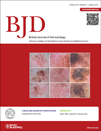Prolonged elevation of serum granulysin in drug-induced hypersensitivity syndrome
N. Saito
Department of Dermatology, Hokkaido University Graduate School of Medicine, N15 W7, Kita-ku, Sapporo 060-8638, Japan
Search for more papers by this authorR. Abe
Department of Dermatology, Hokkaido University Graduate School of Medicine, N15 W7, Kita-ku, Sapporo 060-8638, Japan
Search for more papers by this authorN. Yoshioka
Department of Dermatology, Hokkaido University Graduate School of Medicine, N15 W7, Kita-ku, Sapporo 060-8638, Japan
Search for more papers by this authorJ. Murata
Department of Dermatology, Hokkaido University Graduate School of Medicine, N15 W7, Kita-ku, Sapporo 060-8638, Japan
Search for more papers by this authorY. Fujita
Department of Dermatology, Hokkaido University Graduate School of Medicine, N15 W7, Kita-ku, Sapporo 060-8638, Japan
Search for more papers by this authorH. Shimizu
Department of Dermatology, Hokkaido University Graduate School of Medicine, N15 W7, Kita-ku, Sapporo 060-8638, Japan
Search for more papers by this authorN. Saito
Department of Dermatology, Hokkaido University Graduate School of Medicine, N15 W7, Kita-ku, Sapporo 060-8638, Japan
Search for more papers by this authorR. Abe
Department of Dermatology, Hokkaido University Graduate School of Medicine, N15 W7, Kita-ku, Sapporo 060-8638, Japan
Search for more papers by this authorN. Yoshioka
Department of Dermatology, Hokkaido University Graduate School of Medicine, N15 W7, Kita-ku, Sapporo 060-8638, Japan
Search for more papers by this authorJ. Murata
Department of Dermatology, Hokkaido University Graduate School of Medicine, N15 W7, Kita-ku, Sapporo 060-8638, Japan
Search for more papers by this authorY. Fujita
Department of Dermatology, Hokkaido University Graduate School of Medicine, N15 W7, Kita-ku, Sapporo 060-8638, Japan
Search for more papers by this authorH. Shimizu
Department of Dermatology, Hokkaido University Graduate School of Medicine, N15 W7, Kita-ku, Sapporo 060-8638, Japan
Search for more papers by this authorFunding sources: none.
Conflicts of interest: none declared.
References
- 1 Tohyama M, Hashimoto K. New aspects of drug-induced hypersensitivity syndrome. J Dermatol 2011; 38: 222–8.
- 2 Kardaun SH, Sidoroff A, Valeyrie-Allanore L et al. Variability in the clinical pattern of cutaneous side-effects of drugs with systemic symptoms: does a DRESS syndrome really exist? Br J Dermatol 2007; 156: 609–11.
- 3 Kaspar AA, Okada S, Kumar J et al. A distinct pathway of cell-mediated apoptosis initiated by granulysin. J Immunol 2001; 167: 350–6.
- 4 Chung WH, Hung SI, Yang JY et al. Granulysin is a key mediator for disseminated keratinocyte death in Stevens–Johnson syndrome and toxic epidermal necrolysis. Nat Med 2008; 14: 1343–50.
- 5 Abe R, Yoshioka N, Murata J et al. Granulysin as a marker for early diagnosis of the Stevens–Johnson syndrome. Ann Intern Med 2009; 151: 514–15.
- 6 Fujita Y, Yoshioka N, Abe R et al. Rapid immunochromatographic test for serum granulysin is useful for the prediction of Stevens–Johnson syndrome and toxic epidermal necrolysis. J Am Acad Dermatol 2011; 65: 65–8.
- 7 Shear NH, Spielberg SP. Anticonvulsant hypersensitivity syndrome. In vitro assessment of risk. J Clin Invest 1988; 82: 1826–32.
- 8 Shiohara T, Inaoka M, Kano Y. Drug-induced hypersensitivity syndrome (DIHS): a reaction induced by a complex interplay among herpesviruses and antiviral and antidrug immune responses. Allergol Int 2006; 55: 1–8.
- 9 Ozeki T, Mushiroda T, Yowang A et al. Genome-wide association study identifies HLA-A*3101 allele as a genetic risk factor for carbamazepine-induced cutaneous adverse drug reactions in Japanese population. Hum Mol Genet 2011; 20: 1034–41.
- 10 Picard D, Janela B, Descamps V et al. Drug reaction with eosinophilia and systemic symptoms (DRESS): a multiorgan antiviral T cell response. Sci Transl Med 2010; 2: 46ra62.




